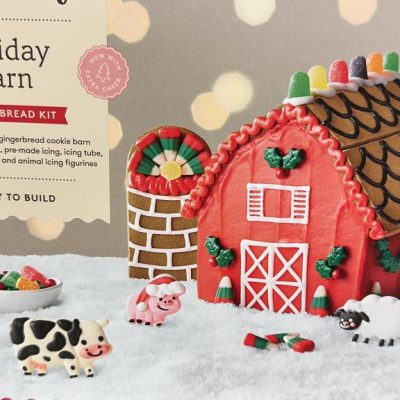by Cheryl Benard
Construction sites at Christmas time – the gingerbread house out of control
During my last visit to Vienna in late autumn, I marvelled at the expanded range of Christmas calendars in shops and supermarkets. In my childhood these had just been flat pieces of cardboard with a picture of St. Nicholas, or Christmas angels, or a magnificently decorated tree, and some gold and glitter sprinkled on them to make them special. The small doors were often difficult to pry open, and behind them you would find “only” a small picture, of a toy drum or a doll. The door for the 24th was larger and showed a nativity scene. Gradually, the motifs modernized, Santa Claus was added or winter sledding scenes with toboggan. Next innovation: a small square of chocolate behind each door, and a larger piece for the 24th.
And now? These were huge boxes, with a Kinder egg or a toy for each day. There were also many variants for adults, with 24 different types of tea, cosmetics or even miniature bottles of liquor. I would have liked to take some of them with me to the USA to show to friends, but they were too big to fit in an average suitcase. It was clear that the old tradition had adapted to modern consumer society and was flourishing. At the same time, I saw that the old “vintage” calendars were back, probably for nostalgic individuals like me.
A few years ago, Christmas calendars also began to make an appearance in the US, but they never really caught on. However, another old tradition has experienced a comparable leap into the modern age: the gingerbread house.
Gingerbread smells wonderful and has a deliciously spicy taste, but it’s not easy to make. Besides ginger you also need several less usual ingredients, and you have to be an experienced baker to get it right, not too soft and not too hard. If you are intending it for a craft project, a gingerbread house, the component pieces must be accurately measured and, otherwise the result will be crooked or will even collapse. But soon, to make this undertaking more user-friendly, you could buy kits with the walls and roof of the house already baked and ready to assemble with the included “glue” – small tubes with sugar paste – and with various candies for decoration. This caught on quickly, because it made a nice activity for children with minimal supervision by parents or older siblings required, and because the result could be proudly displayed as a Christmas decoration. Initially, these houses mostly looked the same, like a basic cottage. Gradually though, innovation set in, and this year saw a great explosion of creativity. The houses now come in a range of architectural styles, from the farmhouse to the English terraced house to the suburban mid-century modern to the futuristic Jetsons residence. There are RVs and beach houses and even sports stadiums.
So, where did this tradition originate? The importance of ginger for health seems to have been first recognized in Chinese medicine, which considered it to be warming, stimulating for digestion and anti-inflammatory. In modern Europe, the first reports of gingerbread state that an Armenian monk transmitted the recipe to his fellow monks in France in the year 992. In the 13th century, subgroups specializing in gingerbread were established within the bakers’ guilds of Germany, first in Ulm and then in Nuremberg. (Nuremberg was located on important trade routes and thus had access to the necessary spices).
German emigrants took the recipe with them to Sweden, where gingerbread was soon being made in abbeys by nuns, as a digestive. In Germany, the right to bake gingerbread was limited to members of the guilds. The exception was the Christmas season, when everyone was allowed to make it. [1]
Tradition-minded people may be appalled by this plethora of commercialized variants of the gingerbread house, but actually, it has always been subject to innovations and fashion. During the reign of Queen Elizabeth I, for example, gingerbread cookies were served at state banquets, baked to resemble the respective guests of honor. In the markets, gingerbread cookies were sold in the shape of soldiers, riders on horseback, rifles, animals and when there was a royal wedding, in the shape of the royal couple. And gingerbread was never just for children; it was customary to eat it by dipping the hard cookies in wine. The military figures, by the way, reflected the common belief that carrying such a gingerbread figure with him could magically protect a soldier in battle.[2]
The recipe for gingerbread was brought to America by the English settlers. George Washington’s mother served it to a prominent dinner guest, the Marquis de Lafayette, which became known and caused a spike in the dessert’s popularity under the name “Gingerbread Lafayette”. (This marquis was an interesting, definitely cookie-worthy personality by the way. As a French aristocrat critical of the monarchy, he sailed for America at the age of 19 and offered himself to the independence fighters as a volunteer. His prior military training made him valuable and he was accepted into the staff of General Washington. There he did well and, despite his young age, soon received the rank of general and his own command. Later he would also play a role in the revolution of his homeland. The American War of Independence had sympathizers in Europe, and important personalities from Poland and Germany also traveled to participate. But back to ginger…) [3]
The gingerbread house, as some historians believe, goes back to the Brothers Grimm and their story of Hansel and Gretel and a witch’s house made of edible treats to entrap hapless children. Others believe that the Grimms were referencing an already existing baking practice.
What do we, an organization dedicated to cultural heritage preservation, think of the current adventurous excesses of the gingerbread house? Bright blue icing on a beach house? Why not! Traditions stay alive by adapting, and the essential idea here is to create something up-to-date based on a venerable old recipe and an old artistic practice. And the Silk Road now stretches from ancient China via Nuremberg all the way to Miami…
[1] – the History of Ginger Bread, see https://www.theguardian.com/travel/2018/dec/22/a-brief-history-of-the-gingerbread-house

